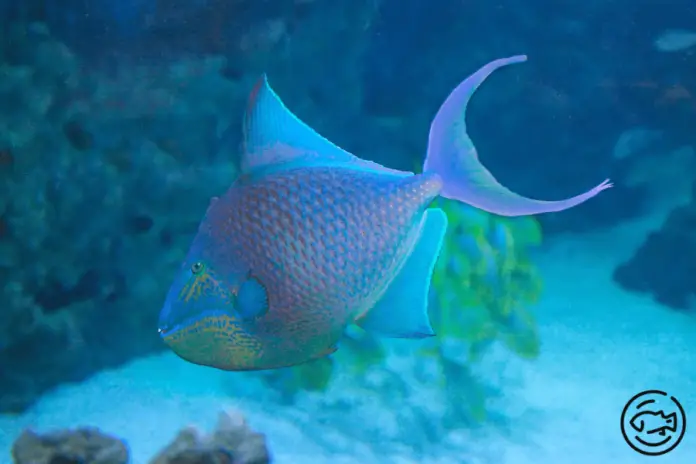The fish gets its name from the fact that it has a large, triangular dorsal fin that is located on its back. The fish also has a small mouth and a large, round body.
The Niger triggerfish is a popular fish among aquarium owners because of its bright colors and interesting behavior.
Physical Appearance

The Niger triggerfish has a distinctive, oval-shaped body with a laterally compressed tail.
They are typically dark blue, with yellow spots on their flanks and dorsal fins.
Their mouths are giant and beak-like, with prominent teeth that they use to crunch up hard-shelled prey. Adults can grow to be up to 40 cm in length.
These fish are named for their large, triangular first dorsal fins, which have a sharp spine on the leading edge.
When threatened, the triggerfish will erect this spine and lock it into place, making it very difficult for predators to swallow them.
The second dorsal and anal fin are both small and rounded.
The pectoral fins of the Niger trigger fish are long and pointed, giving them extra maneuverability in the water.
They use these fins to help them dig into the sand to look for food. The pelvic fins are also long and pointed and are used similarly.
Niger triggerfish has a unique ability among fish: they can alter their skin color to match their surroundings. This camouflage helps them to avoid predators and to surprise their prey.
Lifespan
The triggerfish can live up to 10 years in captivity. However, the lifespan increases in the wild because the natural conditions are ideal for the fish.
When well cared for, the Niger trigger fish can live a long and healthy life.
Tank Size

Tank size is essential when setting up a Niger triggerfish aquarium. These fish are big eaters and grow quite large, so a smaller tank will not be sufficient.
A minimum of 180 gallons is recommended, but a larger tank is always better.
The fish produces a lot of waste, so a sound filtration system is a must.
Canister filters are a good option, as they provide ample filtration for the triggerfish tank. The filter should be protected because these fish like to chew on things and can easily damage the impeller.
You don’t want to buy an expensive filter only to have the fish wreck it, so make sure you get a durable filter that can withstand abuse.
Aquariums with Niger triggerfish should have plenty of hiding places. These fish are not shy and will explore every nook and cranny of the tank.
Live rocks provide perfect hiding spots for them and also help to keep the water quality high.
The triggerfish spray a lot of water when they swim, so a tight-fitting lid is a must. You will drain water from your home every day if you don’t have a lid.
Also, water can cause electrocution if it gets into electrical equipment. So, a lid is crucial for safety reasons as well.
Niger trigger fish are reef-safe, but you have to be cautious.
These fish don’t feed on coral, making them an excellent addition to a reef tank. However, they can be aggressive toward tankmates, so it would be best to keep them with fish that are similar in size.
Put the other fish first because the Niger triggerfish is a territorial fish that may claim the whole tank as its own if given a chance.
Tank Mates

The Niger triggerfish usually work best with fish of similar sizes and operate pleasingly with the following fish as their tank mates:
- Clownfish
- Lionfish
- Angelfish
- Streaked Wrasses
- Damselfish
- Moorish Idols
- Pufferfish
- Rabbitfish
- Tangs
On the other side, you want to avoid fish species that are smaller or tiny in size as they usually have a higher level of aggression.
also read: Hellfire Torch Coral
Tank Substrate

The substrate of your tank is fundamental to the health of your Niger triggerfish. A suitable substrate will help keep the water quality in your tank high and provide a place for your fish to hide and feel comfortable.
Sand is an excellent choice for a substrate, as it is easy to keep clean and provides a natural look for your tank.
You can also choose to use live rock in your tank, which will provide additional filtration and help to keep the water quality high. Choose a substrate that is easy to maintain and provides a comfortable environment for your fish.
Add some rocks and coral to your triggerfish tank for adding hiding places and a more natural-looking environment.
Water Quality
Water is the lifeblood of your Niger trigger fish tank, so it’s crucial to maintain high water quality.
Changes in the water quality can be stressful for your fish and lead to disease. Ammonia, nitrites, and nitrates are the most significant water quality concerns in a triggerfish tank.
Ammonia is developed by breaking fish waste and uneaten food, while the breakdown of ammonia produces nitrites and nitrates. All these toxins can build up in the water and harm your fish.
To maintain high water quality, you should perform regular water changes and use a good filtration system. A water change of 20-30% should be done every week or two, and a good filtration system will help remove toxins from the water.
Tap water can contain toxins that harm your fish, so utilize a toxin-removing conditioner when adding new water to your tank. A water conditioner will remove these toxins, making it safe for your fish.
Also, be sure to keep an eye on the temperature of the water. Niger triggerfish prefer water that is between 75 and 82°F. Sudden temperature changes can be stressful for your fish and lead to disease.
Tank Decoration
A plain tank is not only dull for you as the owner but also for your Niger triggerfish. They need stimulation and hiding places, so live, artificial plants, rocks, and other decorations are necessary.
Be careful with your choice of decoration as Niger trigger fish are notorious for uprooting or moving things around the tank. Anything not firmly anchored will likely become a target for their antics.
Some plants that can withstand a triggerfish’s abuse are the Java fern, Malaysian Trumpet Plant, and Anubias species. All these plants have tough leaves and root systems that make it difficult for Niger trigger fish to uproot.
Be aware of toxic plants which can cause serious health problems if consumed by your Niger triggerfish.
Diet

Niger trigger fish are not fussy and accept most aquarium foods, including frozen, life, and flake options. They are particularly fond of small crustaceans, such as mysid shrimp and brine shrimp.
To keep your triggerfish healthy and happy, offer a varied diet that includes meaty and vegetable-based foods.
When choosing a food for your triggerfish, look for something that is sinking or slow-moving. These fish are adept at snatching food from the water column but may have trouble competing with faster swimmers for floating pellets or flakes.
Sinking pellets or granules are a good option, and you can also offer blanched vegetables like zucchini or spinach.
The diet should be balanced with meaty and vegetable-based options to ensure that your Niger trigger fish gets all the nutrients it needs.
Niger triggerfish are known for their hearty appetites and can be pretty aggressive regarding feeding time.
Feeding them small meals several times a day rather than one large feeding is best. This will help reduce aggression and ensure that everyone in the tank gets a chance to eat.
Breeding

It’s hard to identify a male Niger trigger fish from a female; therefore, breeding them is impossible. The best way to get a new Niger triggerfish is to buy one from a pet store.
Niger triggerfish are egg-layers, and the female will lay eggs in batches of up to 2000. The male will safeguard the eggs until they hatch, which can take approximately 24-36 hours. Once they hatch, the fry can fend for themselves.
Diseases
Just like other pets, triggerfish are susceptible to a variety of diseases. Some of the more common diseases include:
Bacterial Infection
Bacterial infections are the most common type of infection in triggerfish.
Loss of appetite, white spots on the skin, and red lesions are all symptoms of a bacterial infection.
The infection can be caused by several things, including poor water quality and stress. If not treated promptly, a bacterial infection can be fatal.
Antibacterial medicines from the vet can help to treat a bacterial infection.
Depression
Depression is common in triggerfish that are kept in captivity. The fish may become lethargic and stop eating. Inadequate food and a lack of stimulation can contribute to depression in triggerfish.
Monitor your triggerfish’s behavior and ensure they are getting enough to eat. If you think your fish is depressed, talk to your vet.
Parasites
Parasites are also relatively common in triggerfish. Symptoms of parasites include itching, scratching, and inflammation. Parasites can enter the fish’s body through the gills or skin and can be ingested.
Various treatments are available for parasites, including medication and dips. Your vet will be able to brief you on the best course of treatment for your fish.
Is The Niger Triggerfish A Good Pet?
The Niger triggerfish is a beautiful and unique fish that can make a great pet. They are active and exciting to watch and not too difficult to care for.
However, the fish requires some level of commitment to thrive.


